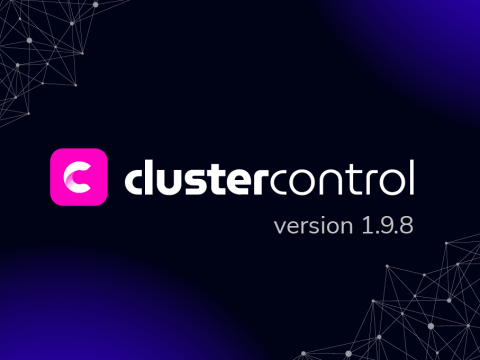blog
ClusterControl adds in-place major PostgreSQL upgrade and pgvector extension in latest release

We’re thrilled to announce that ClusterControl (CC) version 1.9.8 is now available! This latest release brings a range of exciting features to ClusterControl users, including an in-place major version upgrade for PostgreSQL, the addition of the pgvector extension, and a minor version upgrade for MongoDB users.
Let’s dive into the details to help you get up and running with these latest enhancements.
Update your PostgreSQL server to the latest version in-place
An in-place PostgreSQL major upgrade involves upgrading your current PostgreSQL instance to a newer major version directly on the same server. This method uses the pg_upgrade tool to facilitate a smooth transition to the latest version.
If your PostgreSQL database is running on an outdated version, we strongly advise upgrading to a newer version to reap the following benefits:
- Reduced downtime: keep your databases accessible and online throughout the upgrade, preventing interruptions to applications and users
- Time-saving: upgrade large datasets without the need for extensive backup and restore procedures
- Enhanced compatibility: transition your environment with seamless conversions and updates between old and new PostgreSQL versions
In summary, performing an in-place PostgreSQL major upgrade will enable you to take advantage of vital built-in functionalities, security updates, performance improvements, and implementations beneficial for database management.
How to upgrade your PostgreSQL version from the ClusterControl GUI:
Upgrading your PostgreSQL version with ClusterControl is easy with our intuitive wizard. Just follow these simple steps:
- Click on your PostgreSQL cluster
- In the menu, navigate to Upgrades and select between a minor or major PostgreSQL upgrade
- Choose your preferred upgrade method of copy, link, or pgdumpall
- Submit your upgrade request
To help you through the upgrade process, refer to our documentation.
Work with AI-based workloads using PostgreSQL’s pgvector
Pgvector, an open-source extension designed for PostgreSQL, functions as a robust tool for managing embeddings within PostgreSQL environments.
A significant addition to the PostgreSQL ecosystem, pgvector excels in identifying both precise and approximate nearest neighbors, thereby facilitating search functionality, recommendations, and anomaly detection.
Let’s delve into the powerful features and compelling use cases of pgvector.
Key features and benefits of pgvector:
- Supports multiple embedding types: facilitates storage and effective search of embeddings with different dimensions and data types, including text, images, and audio
- Offers approximate nearest neighbor search: identifies the nearest neighbors of a given query, offering both exact and approximate results
- Provides seamless integration: easily integrates with PostgreSQL, allowing users to leverage essential PostgreSQL features such as indexing and querying
- Scales as you grow: tailored to accommodate large datasets, ensuring optimal performance in production environments
Explore pgvector use cases:
- Search: implement search functionality across different data types, including product search, image search, and text search
- Recommendation: provide personalized recommendations to users based on their historical interactions or preferences
- Anomaly detection: identify outliers and anomalies within your data
How to enable pgvector from the ClusterControl GUI:
- Click on Deploy a cluster (Note: PostgreSQL version 15 supports the pgvector extension)
- Select the pgvector extension
- Connect to your PostgreSQL database
- Preview your changes and click Finish to complete your updates
For more information, check our documentation and this pgvector resource.
Upgrade your MongoDB version to the latest minor version
If you’re a MongoDB user looking to perform a minor upgrade, we have you covered! This release also includes support for minor upgrades for replicaset and sharded clusters.
Head to the Upgrades tab in ClusterControl, conduct a quick version check and proceed with the upgrade process.
For more information, see our documentation for all the details.
Discover more updates in ClusterControl v1.9.8
ClusterControl v1.9.8 offers a range of other enhancements across MongoDB, MySQL, and the user interface:
MongoDB updates:
- Now includes support for the user’s self-signed certificate configuration
MySQL updates:
- New DB Status and DB variable tabs, enabling list, search, and display differences in the server statuses and configuration variables for MySQL-based clusters
- Ensures consistent software versions are available for new replicas and primary nodes during the initial cluster deployment
Interface improvements:
- Cluster details header now displays cluster and node status, enhancing visibility
- Consolidated menu items to facilitate easy identification of action groups
- Added shortcuts for toggling auto recovery options for clusters
- Updated the edit cluster details dialog
Wrapping up
We’re committed to adding new ClusterControl capabilities as we strive to empower you to deploy, monitor, and scale your open-source databases in various environments (cloud, on-premise, hybrid).
Stay tuned for the next exciting ClusterControl release (v1.9.9), featuring support for the Redis Cluster, additional upgrades to multiple databases, and the ability to scale CC to thousands of nodes.
For more insights into v1.9.8, visit our changelogs for the details!
New to ClusterControl? Try our Enterprise edition free for 30 days and get technical support to guide you throughout your journey.




